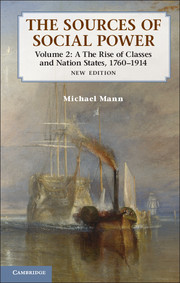Book contents
- Frontmatter
- Contents
- Preface to the new edition
- Preface
- 1 Introduction
- 2 Economic and ideological power relations
- 3 A theory of the modern state
- 4 The Industrial Revolution and old regime liberalism in Britain, 1760–1880
- 5 The American Revolution and the institutionalization of confederal capitalist liberalism
- 6 The French Revolution and the bourgeois nation
- 7 Conclusion to Chapters 4–6: The emergence of classes and nations
- 8 Geopolitics and international capitalism
- 9 Struggle over Germany: I. Prussia and authoritarian national capitalism
- 10 Struggle over Germany: II. Austria and confederal representation
- 11 The rise of the modern state: I. Quantitative data
- 12 The rise of the modern state: II. The autonomy of military power
- 13 The rise of the modern state: III. Bureaucratization
- 14 The rise of the modern state: IV. The expansion of civilian scope
- 15 The resistible rise of the British working class, 1815–1880
- 16 The middle-class nation
- 17 Class struggle in the Second Industrial Revolution, 1880–1914: I. Great Britain
- 18 Class struggle in the Second Industrial Revolution, 1880–1914: II. Comparative analysis of working-class movements
- 19 Class struggle in the Second Industrial Revolution, 1880–1914: III. The peasantry
- 20 Theoretical conclusions: Classes, states, nations, and the sources of social power
- 21 Empirical culmination – over the top: Geopolitics, class struggle, and World War I
- Appendix: Additional tables on state finances and state employment
- Index
- References
6 - The French Revolution and the bourgeois nation
Published online by Cambridge University Press: 05 July 2013
- Frontmatter
- Contents
- Preface to the new edition
- Preface
- 1 Introduction
- 2 Economic and ideological power relations
- 3 A theory of the modern state
- 4 The Industrial Revolution and old regime liberalism in Britain, 1760–1880
- 5 The American Revolution and the institutionalization of confederal capitalist liberalism
- 6 The French Revolution and the bourgeois nation
- 7 Conclusion to Chapters 4–6: The emergence of classes and nations
- 8 Geopolitics and international capitalism
- 9 Struggle over Germany: I. Prussia and authoritarian national capitalism
- 10 Struggle over Germany: II. Austria and confederal representation
- 11 The rise of the modern state: I. Quantitative data
- 12 The rise of the modern state: II. The autonomy of military power
- 13 The rise of the modern state: III. Bureaucratization
- 14 The rise of the modern state: IV. The expansion of civilian scope
- 15 The resistible rise of the British working class, 1815–1880
- 16 The middle-class nation
- 17 Class struggle in the Second Industrial Revolution, 1880–1914: I. Great Britain
- 18 Class struggle in the Second Industrial Revolution, 1880–1914: II. Comparative analysis of working-class movements
- 19 Class struggle in the Second Industrial Revolution, 1880–1914: III. The peasantry
- 20 Theoretical conclusions: Classes, states, nations, and the sources of social power
- 21 Empirical culmination – over the top: Geopolitics, class struggle, and World War I
- Appendix: Additional tables on state finances and state employment
- Index
- References
Summary
The central issue in analyzing the French Revolution traditionally has been whether it was a class revolution. Historians from Jaures to Lefebvre said yes, analyzing the Revolution as a class struggle between a feudal old regime and a capitalist bourgeoisie. But three revisions have disputed this. Since Cobban (1964), empirical studies showed that the Revolution began as old regime factional fighting and continued under nonbourgeois leadership. The second revision, centered on Behrens (1967) and Skocpol (1979), sees the Revolution triggered by a fiscal crisis caused by Great Power rivalry. Only through this fiscal crisis did class struggle emerge. The third revision, offered by Ozouf (1976), Furet (1978), Agulhon (1981), Hunt (1984), and Sewell (1985), sees the Revolution as essentially ideological, driven by ideas, emotions, and cultural forms, classes being mobilized more symbolically than materially. This has become the new conventional wisdom: codes have replaced classes among historians of France. The intelligentsia has turned inward.
I accept some of all these arguments. As usual, my explanation entwines ideological, economic, military, and political power networks. The Revolution did not begin as a class struggle, except for the peasantry, but it became a class struggle, just as it became a national struggle. Classes were not “pure” but also were defined by ideological, military, and political forces. The Revolution became bourgeois and national, less from the logic of development from feudal to capitalist modes of production than from state militarism (generating fiscal difficulties), from its failure to institutionalize relations between warring elites and parties, and from the expansion of discursive ideological infrastructures carrying principled alternatives.
- Type
- Chapter
- Information
- The Sources of Social Power , pp. 167 - 213Publisher: Cambridge University PressPrint publication year: 2012



